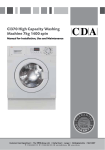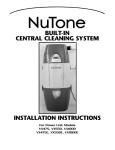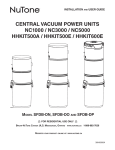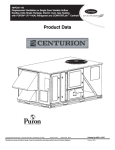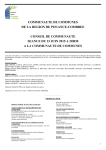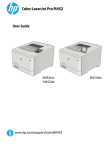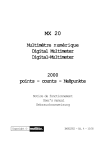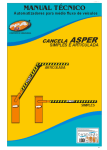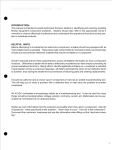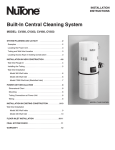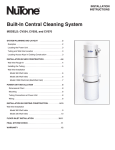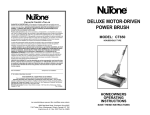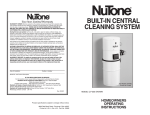Download NuTone PP650 Installation Guide
Transcript
INSTALLATION GUIDE CENTRAL VACUUM POWER UNITS PUREPOWER SERIES PP500, PP600 & PP650 AB0039 ! FOR RESIDENTIAL USE ONLY BROAN-NUTONE LLC; HARTFORD, WISCONSIN ! WWW.NUTONE.COM 1-888-336-3948 REGISTER YOUR PRODUCT ONLINE AT: WWW.NUTONE.COM/REGISTER MODELS SFDB-DQ, SFDB-DR AND SFDB-DS 30042508A IMPORTANT SAFETY INSTRUCTIONS SAVE THESE INSTRUCTIONS READ ALL INSTRUCTIONS BEFORE USING THIS APPLIANCE When using an electrical appliance, basic precautions should always be followed, including the following: WARNING CAUTION ! To reduce the risk of fire, electric shock or injury: 1. Do not put any object into openings. Do not use with any opening blocked; keep free of dust, lint, hair and anything that may reduce air flow. 1. Do not use on wet surfaces or outdoors. 2. Do not vacuum liquids or fine powders (such as drywall dust). 2. Ensure air flows freely and exhausts unobstructed from top or side outlet. 3. Do not use to pick up flammable or combustible liquids such as gasoline or use in areas where they may be present. 3. Do not use without filter (or filters, according to the model) in place. 4. Do not pick up anything that is burning or smoking, such as cigarettes, matches, or hot ashes. 4. Do not use to blow leaves or debris. 5. Do not allow to be used as a toy. Close attention is necessary when used by or near children. 5. Do not place any object on top of the unit. 6. Use only as described in this manual. Use only manufacturer's recommended attachments. 7. Do not use the pail as a wash bucket. 6. Do not install the unit horizontally. 7. Keep hair, loose clothing, fingers and all parts of body away from openings and moving parts. 8. Do not use the pail as a stool. 8. Turn off all controls before unplugging. 10. This appliance is for use on a standard 120 VAC, dedicated 15-amp branch circuit. 9. Avoid picking up sharp objects. 9. Use extra care when cleaning on stairs. 11. Do not unplug the unit by pulling on cord. To unplug, grasp the plug, not the cord. 10. Do not handle plug or appliance with wet hands. 11. Do not use with damaged cord or plug. If appliance is not working as it should, if it has been dropped, damaged, left outdoors, or dropped into water, return it to a Service Center. 12. Store your vacuum cleaner indoors in a clean, dry area, and away from extreme temperatures. 12. Keep your work area well lighted. 13. Any servicing other than that recommended in this manual should be performed by an authorized service facility. 13. Connect to a properly grounded outlet only. See grounding instructions shown on page 10. 14. We recommend that your unit be inspected by a specialized technician once a year. 14. When performing installation, servicing or cleaning the unit, it is recommended to wear safety glasses and gloves. 2 TABLE OF CONTENTS SYSTEM PLANNING LAYOUT . . . . . . . . . . . . . . . . . . . . . . . . . . . . . . . 4-5 THE RANCH STYLE HOUSE . . . . . THE TWO-STORY HOUSE . . . . . . THE SPLIT-LEVEL HOUSE. . . . . . LOCATING THE POWER UNIT . . . . THE RANCH STYLE HOUSE . . . . . TUBING AND WALL INLET LOCATIONS . . . . . . . . . . . . . . . . . . . . . . . . . . . . . . . . . . . . . . . . . . . . . . . . . . . . . . . . . . . . . . . . . . . . . . . . . . . . . . . . . . . . . . . . . . . . . . . . . . . . . . . . . . . . . . . . . . . . . . . . . . . . . . . . . . . . . . . . . . . . . . . . . . . . . . . . . . . . . . . . . . . . . . . . . . . . . . . . . . . . . . . . . . . . . . . . . . . . . . . . . . . . . . . . . . . . . . . . . . . . . . . . . . . . . . . . . . . . . . . . . 4 4 4 5 5 5 GENERAL INSTALLATION GUIDE . . . . . . . . . . . . . . . . . . . . . . . . . . . . . 5-6 TOOL LISTING . . . . . . . . . . . . . . . . . . . . . . . . . . . . . . . . . . . . . . . . . . . . . . . . . . . 5 WORKING WITH PLASTIC TUBING. . . . . . . . . . . . . . . . . . . . . . . . . . . . . . . . . . . . . . . . . . 5-6 INSTALLATION IN NEW CONSTRUCTION . . . . . . . . . . . . . . . . . . . . . . . . . 7-10 WALL INLET ROUGH-IN . . . . . . . . . . . . . . . . . . . . . . . . . . . . INSTALLING THE TUBING . . . . . . . . . . . . . . . . . . . . . . . . . . . . WALL INLET INSTALLATION . . . . . . . . . . . . . . . . . . . . . . . . . . CI390 ELECTRAVALVE™ ELECTRIFIED INLET INSTALLATION (CI395RK ROUGH-IN) . . . . . . . . . . . . . . . . . . . . . . . . . . . . . . . . . . . . . . . . . . . . . . . . . . . . . . . . . . . . . . . . . . . . . . . . . . . . . 7 8 9 10 CI1358 SUPERVALVE™ WALL INLET & ROUGH-IN KIT . . . . . . . . . . . . . . . . . . 11 INSTALLATION IN EXISTING CONSTRUCTION . . . . . . . . . . . . . . . . . . . . . 12-18 LOCATING ACCESS KEYS IN EXISTING CONSTRUCTION . . . . . . . AVOIDING IN-WALL OBSTACLES . . . . . . . . . . . . . . . . . INSTALLING THE INLET TUBING . . . . . . . . . . . . . . . . . . WALL INLET INSTALLATION . . . . . . . . . . . . . . . . . . . C370 OR 360 SERIES INLETS (CF361 OR CF361F ROUGH-IN) . MODEL 330 SERIES WALL INLET INSTALLATION (CF329 ROUGH-IN) FLOOR INLET INSTALLATION IN NEW AND EXISTING CONSTRUCTION . . . . . . . . . . . . . . . . . . . . . . . . . . . . . . . . . . . . . . . . . . . . . . . . . . . . . . . . . . . . . . . . . . . . . . . . . . . . . . . . . . . . . . . . . . . . . . . . . . . . . . . . . . . . . . . . . . . . . . . . . . . . . . . . . . . . . . . . . . . . . . . . . . . . . . . . . . . . . . . . . . . . . . . . . . . 12 . . 12 12-14 14-16 16-17 17-18 . . 18 CI365 VACPAN™ INSTALLATION INSTRUCTIONS . . . . . . . . . . . . . . . . . . . 19-20 INSTALLATION TIPS . . . . . . . . . . . . . . . . . . . . . . . . . . . . . . . . . . . . . . . . . . . . . . . . . 19 UNDER CABINET INSTALLATION . . . . . . . . . . . . . . . . . . . . . . . . . . . . . . . . . . . . . . . . . . . 19 IN WALL INSTALLATION . . . . . . . . . . . . . . . . . . . . . . . . . . . . . . . . . . . . . . . . . . . . . . . 20 CI367 VACUSWEEP® INLET VALVE INSTALLATION INSTRUCTIONS . . . . . . . . . 21-23 CONNECTION FROM BELOW . . . . . . . . . . . . . . . . . . . . . . . . . . . . . . . . . . . . . . . . . . . . . 21 CONNECTION FROM BEHIND . . . . . . . . . . . . . . . . . . . . . . . . . . . . . . . . . . . . . . . . . . . . . 22 CONNECTION IN A WALL . . . . . . . . . . . . . . . . . . . . . . . . . . . . . . . . . . . . . . . . . . . . . . 23 ASSEMBLING THE TUBING SYSTEM . . . . . . . . . . . . . . . . . . . . . . . . . . 24-26 POWER UNIT INSTALLATION . . . . . . . . . . . . . . . . . . . . . . . . . . . . . . 27-29 CHANGING INTAKE LINE DIRECTION . . . . . . . . . . . . . . . . . . . . . . . . . . . . . . . CONVERTING POWER UNIT FROM CYCLONIC OPERATION TO A BAGGED SYSTEM (DEBRIS BAG INCLUDED) MOUNTING THE POWER UNIT . . . . . . . . . . . . . . . . . . . . . . . . . . . . . . . . . . FITTING MAIN LINE TO POWER UNIT . . . . . . . . . . . . . . . . . . . . . . . . . . . . . . . . . . . . . . . . . . . . . . . . . . . . . . . . . . . . . . . . . . . . 27 . 27 . 28 . 29 GROUNDING INSTRUCTIONS . . . . . . . . . . . . . . . . . . . . . . . . . . . . . . . . 29 WIRING . . . . . . . . . . . . . . . . . . . . . . . . . . . . . . . . . . . . . . . . . . . . . . . . . . . . . . 29 FINAL SYSTEM CHECK. . . . WARRANTY . . . . . . . . . . TROUBLESHOOTING GUIDE. SERVICE PARTS . . . . . . . . . . . . . . . . . . . . . . . . . . . . . . . . . . . . . . . . . . . 3 . . . . . . . . . . . . . . . . . . . . . . . . . . . . . . . . . . . . . . . . . . . . . . . . . . . . . . . . . . . . . . . . . . . . . . . . . . . . . . . . . . . . . . . . . 30 . 30 . 31 . 32 SYSTEM PLANNING AND LAYOUT The NuTone central cleaning system consists of a power unit, PVC tubing and fittings, wall inlets, a flexible hose and various cleaning attachments. The power unit is designed to be wall-mounted away from the living area of the home and connected to the living area by means of permanently installed in-wall tubing, fittings and inlets. Generally, an installation will require 3 to 4 inlets and 16 to 20 feet of tubing per inlet. It is suggested that a floor plan be used to more accurately determine the quantity of materials needed. Use the following examples as an aid in planning the installation in either new or existing construction. You should be able to adapt the examples shown to your specific home layout. THE RANCH STYLE HOUSE Here the power unit is mounted in the garage. The intake and exhaust tubing, the only exposed tubing in the installation, runs up the garage wall and into the attic. The trunk line runs horizontally through the attic from the power unit to the farthest inlet location. Branch lines spread throughout the attic, connecting the trunk line to the inlet tubing. Each inlet tube is threaded vertically through an inside wall. Located in hallways and in large rooms, the inlets are placed to provide maximum access to all cleaning areas. See figure at right. BRANCH LINE TRUNK LINE EXHAUST INLET LINE INLETS POWER UNIT INTAKE AH0003A THE TWO-STORY HOUSE ATTIC TRUNK LINE A double-trunk line system is commonly used in two-story houses. In the installation shown at right, the power unit is mounted in the basement. The intake tubing runs up the basement wall and connects to the main trunk line, which runs along the unfinished basement ceiling. Two first-floor inlets are connected to the basement trunk line by vertical inlet lines run through interior walls. In the center of the house, a vertical branch line runs from the basement trunk line, through stacked closets, up into the attic. A second trunk line runs across the attic and two branch lines connect to inlet lines which are dropped down through upstairs interior walls. See figure at right. INLET LINE VERTICAL BRANCH LINE INLET INTAKE BASEMENT TRUNK LINE POWER UNIT EXHAUST AH0005A THE SPLIT-LEVEL HOUSE Like the two-story house, the split level installation commonly calls for a two-level trunk line. Here, the power unit is located in the garage. The intake tubing runs exposed up the garage wall and into the ground level section's attic. Two branch lines connect this part of the trunk line to inlet lines which are dropped inside interior walls. A vertical branch line runs to the upstairs attic, where the trunk line branches into a T-shape. This trunk line connects to two upstairs inlet lines and to one inlet line which drops through an upstairs wall and down into the third-level utility room to service this entire level. See figure at right. BRANCH LINES VERTICAL BRANCH LINE TRUNK LINE EXHAUST INLET LINE INTAKE INLET POWER UNIT AH0004A 4 BRANCH INLET LINE SYSTEM PLANNING AND LAYOUT (CONT'D) ! TUBING AND WALL INLET LOCATIONS WARNING Do not install outdoors. When performing installation, servicing or cleaning the unit, it is recommended to wear safety glasses and gloves. Locate inlets on interior walls, choosing central locations which allow several rooms to be cleaned from a single inlet using a 30-foot long hose. The tubing installation should consist of a main trunk line running from the farthest wall inlet to the power unit location, with branch lines running to each additional inlet. Keep all tubing lines as straight as possible and use as few fittings as possible. Beginning at the area farthest from the power unit, choose a tentative inlet location. Measure 30 feet from the proposed inlet location to the farthest corner of the rooms to be cleaned by that inlet to determine if inlet location is proper. If working from blueprints (or building plans drawn at 1⁄4" = 1 ft. scale), use a 7½" chain as your guide to determine inlet locations. Locate inlets within six feet of an electrical receptacle to allow use of optional current-carrying hose. Be sure inlets will not be blocked by doors or furniture. Be sure inlets will not interfere with electrical, plumbing or other mechanical installations. Move tentative inlet location if necessary. Use the same procedure to determine each additional inlet location, always working toward the power unit. LOCATING THE POWER UNIT • Locate the power unit away from the general living area in an accessible location for cleaning and maintenance. • When planning the installation of PP650 power unit, remember it is equipped with an inlet to service a garage, basement, utility room, etc., wherever it is located. • Locate the power unit within 6 feet of a grounded electrical outlet. The power unit requires a 120 VAC power source. • Do not locate the power unit close to a source of extreme heat (i.e.: water heater) or in an area with a high ambient temperature (i.e.: attic, furnace room). • If the power unit is located in a closet or a small utility room, make sure the area is well-ventilated (e.g.: with door louvers). • Exhausting the power unit to the outside is recommended for optimal performance. The exhaust should not be vented into a wall, a ceiling or a concealed space in the house. The exhaust line should be vented outside the home using a Model 393 or CI330 wall caps. GENERAL INSTALLATION GUIDE ! WARNING When applicable local regulations comprise more restrictive installation and/or certification requirements, the aforementioned requirements prevail on those of this document and the installer agrees to conform to these at his own expenses. TOOL LISTING Depending on your installation, you may require the use of these tools. The power tools are recommended to make your installation proceed quickly. Also, plan a mask when cutting ducting (PVC dust) and gloves when using glue. • • • • • Wire Strippers Utility Knife Knife 2½" Hole Saw 1/2" Drill • • • • • 1/4" Drill Putty Knife Hammer Keyhole Saw Cold Chisel • • • • • Level Drill Bit Screwdriver Wrench Tape Measurer • • • • Flashlight Electrical tape Safety Glasses Hacksaw WORKING WITH PLASTIC TUBING CUTTING THE TUBING Before you cut a length of tube, accurately measure the length you need. Allow 5/8” of tubing for inserting into fittings and 1½” for placing into flexible tubing. Cut the plastic tubing with a hacksaw, making sure that the cut is exactly square. (You can use a tube cutter if one is available.) Use wire cutters or tin snips to cut flexible tubing. The 8” lengths of flexible tubing supplied with each inlet should not be cut. See figure at right. Use a small knife to remove any burrs from the inside of the tube. You can also use steel wool to remove burrs. The burrs must be removed or they may impede air flow of form clogs by snagging hair and carpet thread. See figure at right. AR0017 AR0016 5 GENERAL INSTALLATION GUIDE (CONT'D) CEMENTING FLEXIBLE TUBING WORKING WITH PLASTIC TUBING (CONT'D) Make sure the ends of the flexible tubing are even—trim if necessary. When you join flexible tubing to plastic tubing or to an inlet mounting plate, apply cement to both the inside of the flexible tubing and the outside of the plastic tubing or mounting plate tubing ring. Twist the two pieces as you join them to evenly spread the glue. Allow five minutes for the cement to set in flexible tubing. You may also use electrical tape or duct tape to further seal the joint. CUTTING THE TUBING (CONT'D) Next, use a file to slightly bevel the outside of the tube so that it will easily slide into the fitting. Use steel wool or a light grained sandpaper to buff the surface of the tube which will be glued. This will clean the tube and assure a good seal. See figure at right. AR0018 SECURE WIRE TO TUBING MAKING A JOINT The low-voltage power wiring is run along with the tubing. To insure that the wire is secure and will not hang-up in a wall, use electrical tape to attach the wire to the tubing. Tape the wire approximately every 12-18 inches. See figure at right. Insert the tube into the fitting, aligning the two parts as they will be installed. Mark the tube and the fitting so that you can quickly realign the joint. See figure at right. AR0019 Apply cement only to the outside of the tube. Dab the cement generously in an inch-wide band. Insert the tube into the fitting with the alignment marks a quarter turn apart, and then quickly push and turn the fitting to align the marks and spread the cement. Allow one minute for the joint to dry. You may also use electrical tape or duct tape to further seal the joint. See figure at right. AO0010 6 AO0011 INSTALLATION IN NEW CONSTRUCTION WALL INLET ROUGH-IN Once the locations for the wall inlets have been determined, mount all inlet brackets. Choose the appropriate mounting bracket for the inlet being installed. (See chart below.) ROUGH-IN SERIES 395 396-3 CI3301RK CI3303RK CF329 X X X WALL VALVE SERIES 330 360 X X CI335 CF361 CF361F X X CI395RK X CI358 Rough-in and wall valve sold together CI390 X CI395 X To locate a bracket on a wall stud, measure approximately 18" up from finished floor level. (Height may vary according to individual preference.) MODELS CF361 & CF361F (FOR USE WITH 360 INLET) MODELS CF329 (FOR USE WITH 330 INLETS) Refer to figure below. Nail bracket to the side of the stud so that the front edge of the bracket is flush to the front of the stud. (The bracket may also be nailed to the front edge of the stud. See face mounting illustrated. For face mounting, use locating tabs on bracket for proper alignment.) When using Model CF329, glue elbow to mounting plate. Attach to stud as shown in figure at right. MODEL CF361 & CF361F SIDE MOUNTING FACE MOUNTING 2 3/8" 113 /16" AD0015 AD0059 Refer to figure below. Remove cardboard from plaster guard frame. Using four (4) provided screws, attach the appropriate flanged fitting and inlet seal to back of inlet. Replace cardboard in plaster guard frame AD0060 7 INSTALLATION IN NEW CONSTRUCTION (CONT'D) INSTALLING THE TUBING Use the following installation guidelines when installing tubing. B C D E F G Start tubing installation at farthest inlet and work toward the power unit. Tubing run to the power unit should be as straight as possible. When assembling sections with elbows and tees, make sure the curve in the fitting is aligned so that the air flows toward the power unit. Branch lines should always join the trunk line from above or from the same level. Never join a branch line from an angle below the trunk line. Refer to figure at right. Run low voltage wiring (Model 376UL) and secure wiring to tubing as tubing is installed. Model CF380 Pipe Support can be used to support long runs of tubing (position near joists) and to clip wire along tubing. Secure tubing to joists or studs. Leave approximately 6" of wire for connection to each inlet. I Refer to figure at right. Cut tubing, keeping cut square. AR0016 J Refer to figure at right. Remove burrs from both inside and outside of tubing. AR0017 K Before cementing, pre-assemble section to inlet fitting, check for proper length. L Refer to figure at right Apply PVC cement (Model 379) to outside of tubing. Coat tubing approximately 1" back. Take care to keep cement from inside of tube. AE0040 Cut a 2½" diameter hole in sole plate, header or stud directly in line with opening of inlet bracket fitting. See figure below for center line dimensions. AR0020 MODEL CF361 MOUNTING 2½” DIA. HOLE THROUGH SOLE PLATE 2 /8” 3 113/16” M 113/16” 113/16” SIDE MOUNTING FACE MOUNTING MODEL CF329 MOUNTING 2” 2½” DIA. HOLE Refer to figure at right. Insert tubing into fitting with a twisting motion to evenly spread cement. Be sure tubing is firmly seated in fitting. AO0012 THROUGH SOLE PLATE N If fittings have been attached to tubing at the end opposite the inlet bracket, be sure alignment is proper before cement sets. O Refer to figure at right. Tape wire to tubing to hold in place and insert through hole in inlet bracket. P Connect each inlet line and branch line into main trunk line. Complete low voltage wiring as main trunk line is continued back to power unit. 113/16” AD0055 H FACE MOUNTING Refer to figure below. Measure length of tubing needed to connect inlet to trunk line. Allow approximately 3⁄4" of tubing for inserting into fittings. 3/4” (19 mm) FITTING INCLUDE FITTING RECESS IN MEASUREMENT TUBING MEASUREMENT PVC TUBING AD0018 3/4” (19 mm) FITTING ! AD0017A WARNING When tubing is run through the wall stud, sole plate, headers or else where building materials will be attached, place a nail plate (Model 378) over that area (on both sides if necessary) to prevent nails from piercing tubing. 8 INSTALLATION IN NEW CONSTRUCTION (CONT'D) NOTE: When wall inlets are installed in walls that are less than 1⁄2" thick or when inlets are installed back-to-back in a wall, the tube of the wall inlet may extend into elbow area of the flanged fitting and cause blockage. Shorten the wall inlet tube to prevent this condition. Refer to figure below. WALL INLET INSTALLATION MODEL 360 WALL INLET (CF361 AND CF361F ROUGH-INS) B C Remove the cardboard plaster guard. MODEL CF365 DOUBLE FLANGED TEE Refer to figure at right. For some drywall or panel construction, the plaster frame will extend beyond the finished wall. In this case, remove plaster frame from mounting bracket by removing mounting screws. WALL INLET AR0045 WALL NOTE: When using the model CF361 and CF361F inlet bracket on walls thinner than 1⁄2", use a 1⁄4" spacer (not furnished) between the wall and the inlet bracket. See figure below. Spacer may be made from plywood, Masonite™, etc. Contact cement may be used to hold spacer in place during assembly. Configuration of spacer may vary depending upon installation. SPACER 1/4" INLET MOUNTING BRACKET 21/4" 31/4" For extra thick walls, use Model 399 Extension Sleeve to connect inlet to the flanged fitting. MODEL 330 WALL INLET (CF329 ROUGH-IN) WALL LESS THAN 1 /2" THICK. PLASTER GUARD HOLE Refer to figure at right. Connect 2-conductor lowvoltage wire to terminal screws on back of wall inlet. AE0040 E Guide excess wire back through the hole in inlet bracket and flanged fitting. F Refer to figure at right. Place inlet into mounting bracket and secure. INLET MOUNTING BRACKET AD0058 AD0057 D SHORTEN MOUNTING PLATE AE0024A 9 B Refer to figure at right. Connect 2-conductor low-voltage wire to terminal screws on back of wall inlet. C Align inlet mounting holes with holes in mounting plate. D Refer to figure at right. Place inlet into mounting plate and secure with two provided screws. INLET AE0024A MOUNTING PLATE INSTALLATION IN NEW CONSTRUCTION (CONT'D) CI390 ELECTRAVALVE™ ELECTRIFIED INLET INSTALLATION (CI395RK ROUGH-IN) B Refer to top figure at right. Fasten the mounting plate to a stud within three studs (48") of an electrical outlet box. Measure and mark the wire 10" from the plug (A). Feed the wire through the top hole in the mounting plate (just above the circular opening). Snap the molded plug into the mounting plate as pictured (B). This will keep it secure and out of harm’s way during drywalling and finishing. Line up the wire at the previously measured 10" mark with the strain of relief channel on the back of the mounting plate. Secure it in place with the supplied wire tie (C). C Refer to top figure at right. Run the inlet wire to the adjacent electric box. If you must run wire through a stud, drill directly through the center of the stud (D). D Refer to bottom figure at right. Place the exposed ends of the two wires into the electrical box through a strain relief channel (E). Tighten the strain relief channel (do not overtighten) on the white sheathing leaving 1⁄2" of this sheathing exposed inside of the outlet box. Fold the 6" of BLACK and WHITE wire into the outlet box. Leave the wires to be connected by the electrician when plug receptacles are being installed. D AE0038 CAUTION Power tools such as routers are not recommended for use with the inlet installation, as removal of drywall with these devices may cause damage to the mounting plate and/or inlet plug. E Once drywall and finishing processes have been completed, remove molded plug from mounting plate (with the aid of a slot screwdriver) and snap it into the wing slot at the back of the inlet (F). NOTE: molded plug fits one way only, with the narrow opening at the top. Insert inlet into the mounting plate and secure inlet to mounting plate with screws provided. NOTE: All electrical devices such as the electrified inlet should be reported to the construction electrician for listing on the inspection report for building inspection purposes. E D NOTE: Plumb inlet to tubing using NuTone Model CF382S 90° ELL fitting. ! WARNING All location and installation direct connect electrified wall valves must conform with all local and municipal building codes. AE0039 10 C1358 SUPERVALVE™ WALL INLET & ROUGH-IN KIT AL0008 SAFETY INSTRUCTIONS FOR HOUSEHOLD USE ONLY. INSTALL ONLY ON A NOMINAL 120 V, 60 Hz, 7 A SUPPLY PROTECTED BY A MAXIMUM 15 A OVERCURRENT PROTECTIVE DEVICE. THE PIN CONNECTOR ON THIS TYPE A WALL VALVE IS INTENDED FOR USE ON A NOMINAL 120 V, 60 Hz, 7 A SUPPLY ONLY. IT IS REQUIRED TO BE WIRED BY A QUALIFIED ELECTRICIAN AND IS REQUIRED TO CONFIRM TO LOCAL ELECTRICAL CODES. ! WARNING Do not operate on wet surfaces! NEW CONSTRUCTION B Install BUILDING WIRE CONDUCTORS (1) through the approved type electrical CONNECTOR (2) (supplied) until they protrude approximately six inches from connector. Seat connector firmly into the opening atop the WIRING COMPARTMENT (4). Insert and secure LOCKING TAB (3). C Splice wires from INLET VALVE RECEPTACLE (7) to the protruding building wire conductors with no. 31 TWIST-ON WIRE CONNECTORS (8) (not supplied). NOTE: WHITE wire to WHITE wire and BLACK wire to BLACK wire. D Feed LOW VOLTAGE RELAY WIRES (5) through opening in the LVT COVER PLATE (6) and connect to the two contact screws of INLET VALVE FACE PLATE (9). E Push Inlet Valve face plate (10) into MOUNTING PLATE (11). At the same time, push ELECTRICAL CONDUCTORS (12) and connectors (8) into WIRING COMPARTMENT (4). Back out the two screws that hold the wiring compartment in place. Slip upper FINISHED WALL CLIP (13) under the screw\heads and tightly fasten both wiring compartment and upper finished wall clip (13) with MOUNTING SCREWS (supplied). Install the lower FINISHED WALL CLIP (14) with screws (supplied). Secure Inlet Valve face plate (10) to mounting plate (11) using the two supplied color matched SCREWS (15). F G ® No. LR 61865 No. 27Z2 ® FINISHED CONSTRUCTION After pipe, low voltage relay control wire, electrical building wires and opening in wall has been cut: B Remove mounting plate NAILING FLANGE (16). Use a hack saw or score with razor knife along dotted line and snap off. C Repeat step B (from NEW CONSTRUCTION). D Install modified mounting plate with short 90° ELL glued in position into wall opening. E Repeat steps C - G (from NEW CONSTRUCTION). 11 INSTALLATION IN EXISTING CONSTRUCTION Use the following procedures for installation in existing construction. Wall inlets in existing construction may be accessed from below (basement or crawl space) or from above (attic). Instructions apply to either method. LOCATING ACCESS KEYS IN EXISTING CONSTRUCTION Unless your home is a ranch-style house where a single trunk line can run directly through the attic or basement, you should first investigate your house to find the key to running your tubing from level to level. Look for an accessible area free from obstructions that will accommodate the 2" tubing. Starting from farthest wall inlet location, install each inlet as described below. Working back toward power unit, connect each inlet line and branch line into main trunk line. See page 24. Complete low voltage wiring as main trunk line is continued back to power unit. Mount power unit and complete wiring. See pages 27-29. If you understand how your existing home is constructed, it can be relatively easy to find access routes to run the tubing. Refer again to the illustrations on page 4 as you consider your home construction. AVOIDING IN-WALL OBSTACLES Some of the keys you might find in your home are illustrated here. The tubing which connects the inlet into the trunk line is threaded through interior partition walls. After you’ve chosen an inlet location, make sure the wall doesn’t contain some hidden obstacle which will prevent you from running tubing to the inlet. STACKED CLOSETS OR LAUNDRY CHUTE Many homes will have an upstairs closet located directly above a downstairs closet. It is easy to run the tubing from one floor level to another inside these stacked closets. In these installations the tubing is often left exposed inside the closets. See figure below. A laundry chute could also provide access from basement to upper floors. You may also want to consider running exposed tubing through cabinets or cupboards. ELECTRICAL WIRING The insulation in these walls will prevent you from running tubing through them. EXTERIOR WALLS Wiring may not obstruct your tubing, but you should always make sure that tubing does not damage the wiring. Electrical outlets and wall switches are signs of wiring. DUCTWORK Avoid choosing a section of wall that contains ducting. If you see signs of ductwork—such as floor or ceiling registers— move your inlet location to another section of the wall. PLUMBING Plumbing may or may not prevent you from running tubing through a wall. If you must choose a plumbing wall for an inlet location, be extremely careful when making a cutout in the wall. WALL STUDS Make sure your location is between wall studs. Locate studs by tapping walls, looking for electrical outlet (usually fastened to studs), or noticing finishing nails in the floor molding. AD0019 COLD-AIR RETURN INSTALLING THE INLET TUBING A cold-air return often provides a straight run from basement to other levels of the house. See figure below. The ductwork is easily cut for access. Seal around the tube when completing the installation. When your planning is complete, you will have to determine where all the inlets and the power unit will be located. You have also mapped out the location of your trunk line and found the access you need to run vertical tubing from one level of your house to another level. You should have acquainted yourself with the methods of joining plastic tubing and acquired the tools you’ll need to install your NuTone Central Vacuum System. Now, you can begin installation. The first step to install the inlet tubing which connects the wall inlets to the branch lines. As explained before, the inlet lines run inside interior walls. You will find access to these walls through your attic or basement. Briefly, you want to find the exact location in the wall, drill an access hole through the wall plate or header, and insert the tubing into the wall cavity. This part of your installation requires close observation and careful measurements. Take your time and make sure you accurately line up your access holes with the locations you’ve chosen for your wall inlets. AD0061 12 INSTALLATION IN EXISTING CONSTRUCTION (CONT'D) Once you’ve found the location in the partition wall, you must center the access hole in the middle of the wall. Measure half the thickness of the wall and mark the center of the wall where you will drill the access hole. If you cannot see the plate, you can determine this measurement from upstairs. At the nearest doorway, measure the thickness of the wall, including the baseboard. INSTALLING THE INLET TUBING (CONT'D) LOCATING ATTIC ACCESS HOLES Drill the access holes directly above the inlet location. To accurately locate the access hole, you must find the space between wall studs where the inlet is to be located. Observe the area around the inlet location. Look for references you might be able to find in the attic: electrical wiring, ductwork, doorways, etc. Measure and note the distance from these references to the inlet location. In the basement measure a distance equal to half the thickness of the wall, using the reference hole as a starting point. DRILLING THE ACCESS HOLES Enter the attic and find the inlet wall. Have a helper downstairs knock on the top of the wall right above the inlet location; locate the general area by following the sound. Most likely, you will have to clear away insulation. Ask your helper to continue knocking until you locate the area between wall studs directly above the inlet location. Next, measure the thickness of the wall. Mark the exact center of the wall where you will drill the access hole. Remember that the access hole must be placed exactly in the center of the wall. Drywall AR0021A Once you are certain that you’ve located the center of the wall directly above the inlet location, use a 2½” hole saw to cut the access hole through the wall plate or header and into the wall cavity. (A 1/2” drill is recommended.) Remove the drill from the hole carefully. Now, use a flashlight to inspect the wall cavity through the access hole. Make sure no hidden obstacles will interfere with the tube installation. (If this inspection reveals an obstacle, find a new inlet location.) Repeat this procedure in your attic or basement until your access holes are drilled. Drywall Wall Plate LOCATING BASEMENT ACCESS HOLES To locate access holes in the basement, remove the toe molding or baseboard at the base of the inlet wall. Carefully loosen the molding or baseboard by inserting the blade of a putty knife behind it. Force another putty knife between the first knife and the baseboard or wall. Gently hammer a AR0022 cold chisel between the two knife blades, prying the loosened molding away from the baseboard or the baseboard away from the wall. Directly below the inlet location, drill a 1/16” reference hole through the floor into the basement. (If you’re drilling through carpet, use an awl to slightly open the weave. This will keep the carpet from wrapping itself around the drill bit.) Insert a piece of scrap wire or a clothes hanger into the reference hole so you can easily find the hole in the basement. AR0024 AR0025 ASSEMBLING THE INLET TUBING Once you’ve drilled the access holes, you assemble the inlet tubing and insert it into the wall cavity. Refer to “Working With Plastic Tubing” on pages 5-6 before you begin to assemble the inlet lines. Select a section of plastic tubing and an 8” section of the flexible inlet tubing. Apply cement to the outside of the plastic tubing and to the inside of the flexible tubing. Join the two pieces together and allow 5 minutes for them to dry. AR0023 13 AO0013 INSTALLATION IN EXISTING CONSTRUCTION (CONT'D) For a basement installation, assemble the tubing to the inlet flexible tubing in the same way and insert it into the access hole. A basement inlet line is necessarily shorter because it must only reach 18” from the floor to the inlet. Most of the time, basement inlet lines are more easily installed by two people after the inlet hole has been cut in the interior wall. See “Wall Inlet Installation.” INSTALLING THE INLET TUBING (CONT'D) ASSEMBLING THE INLET TUBING (CONT'D) Cut a piece of low voltage wire which is long enough for the complete inlet line, allowing 6” for connections to the inlet wall plate. Secure the wire to the tubing with electrical tape. AO0014 Tuck the 6” wire lead inside the flexible tubing so that it will not snag inside the wall. AO0018 Complete all your inlet lines, and then proceed to your inlet installations. WALL INLET INSTALLATION AO0015 If space permits, you can assemble the entire inlet line by joining two sections of tubing with a stop coupling before dropping the assembly into the access hole. (Remember to only glue the outside of the tubing when joining two pieces of PVC tubing.) Oftentimes, tight attic spaces require AO0016 you to begin your drop and then join the second section of tubing. Of course, the order of assembly, and the length of tubing required depend on your attic space and your wall height. The wall inlet design allows you to work outside the wall— where assembly is easy and all the parts you need are accessible. First, you make a cutout into the wall and locate the flexible tubing attached to the inlet line which you previously threaded into the wall. Then, you attach the flexible tubing to the inlet mounting plate, assemble the other inlet parts, and make the wiring connections. You place the inlet assembly into the wall cutout, sandwiching the wall between the inner and outer parts, and secure the inlet tightly to the wall with two screws. Whatever the case, insert the completed inlet line into the access hole and thread it down inside the wall. The inlet line should be long enough so that it extends above the joists in the attic; at this height, it can be easily connected to the branch and truck lines. When cutting the inlet AO0017 tubing to length, remember that your inlet will be placed at 18” above the floor. MAKING THE WALL INLET CUTOUT Assemble and install the wall inlet as shown in the illustrations and as explained in the next few pages. Be careful and patient as you make your first cutout and install your first inlet by following the procedure step by step—the other inlets will be easy to install in very little time. The wall inlet should be located 18” on-center from the floor and directly in line with the attic or basement inlet tubing hole you have already drilled in the wall plate or header. the wall inlet cutout must be exactly 3 7⁄8” high by 2 7⁄8” wide. It is crucial that you make an accurate cutout, and we have supplied a template to help you. AR0026 14 INSTALLATION IN EXISTING CONSTRUCTION (CONT'D) ATTACHING THE INLET MOUNTING PLATE WALL INLET INSTALLATION (CONT'D) Reach through the inlet hole and locate the inlet tubing. Raise it up inside the wall until you locate the inlet tubing. If the inlet is connected from the basement, have a helper insert the inlet tubing into the access hole until you can see the flexible tubing. Then, pull the flexible tubing through the inlet AO0038 hole and remove the low voltage wiring from inside the tube. If the end of the flexible tubing is not even, trim it so that it is exactly even. MAKING THE WALL INLET CUTOUT (CONT'D) Place the template against the wall so that it is 18” on-center from the floor. Use a level along the top edge of the template to make sure it is square to the wall. Mark your wall for the cutout by tracing around the inside of the template. Then use your pencil to mark the screw hole locations through punched holes at the top and bottom of the template. Remove the template from the wall. Now, remove the nail flange (used for new construction) from the inlet mounting plate. Use pliers to bend this flange along the scored lines until you can break it off. AR0027 3/8” DIA. HOLES Use an awl or icepick to punch pilot holes where you marked the two hole locations. Now, drill two 3⁄8” diameter holes, using the pilot holes as the centers. Locate and drill these holes exactly as marked with the template. AO0039A Apply cement to both the inside of the flexible tubing and to the outside of the mounting plate’s tube ring. Insert the mounting plate’s tube ring in the flexible tubing and twisting the pieces as you join them to spread the cement, and align the mounting plate in a vertical position. AR0028A Also drill four pilot holes in the four corners of the marked area. Make sure these holes are located inside the marked line. Then, using a utility knife, score along the inside of the marked line. For plaster walls, score the plaster deeply, being careful to stay inside the marked line. Nail Flange Pilot holes must be inside marked line AO0040 Hold the assembly in place for a few minutes as the cement sets; allow 5 minutes for the cement to completely dry. Now, strip the ends of the two low voltage wires, and then connect the wires to the screw terminals on the back of the inlet cover. Make sure the wires are tightly secured under the terminal screws. AR0032A Next, use a keyhole saw or a sabersaw to make the cutout. Again, be extremely careful to cut along the inside of the marked line. Cut along inside of marked line CAUTION When cutting into plaster walls, make sure the plaster is firm and secure around the cutout area. AO0042 AO0041 AR0033A 15 INSTALLATION IN EXISTING CONSTRUCTION (CONT'D) Insert the bottom screw into the inlet cover and through the other parts. Give the screw a few turns until it firmly engages in the mounting plate. Now, level and slightly lower the assembly. Make sure the wall is sandwiched between the inner and outer parts—you’ll be able to feel if mounting plate is firmly centered on the inside of the wall. WALL INLET INSTALLATION (CONT'D) ATTACHING THE INLET MOUNTING PLATE (CONT'D) When the wiring is complete, assemble the inlet cover to the tube guard and mounting plate. Insert the top screw through the entire inlet assembly until the screw engages the mounting plate. AO0043 AO0047 Hold the inlet in place and gradually tighten down each screw a little bit at a time. (If you completely tighten down one screw at a time, the mounting plate may pull away from the wall at the loose end and slip back into the cutout.) AR0034 COMPLETING INLET ASSEMBLY Once you have attached the mounting plate to the flexible tubing, pull the low voltage wire through the top wiring hole in the mounting plate. AR0035 Complete all your wall inlet installations in this manner. If your cutouts are accurate, each wall inlet will install more quickly and easily. INLET 360 SERIES INLETS (CF361 OR CF361F ROUGH-IN) MOUNTING PLATE AE0024A NOTE: If 330 wall inlet is being used refer to Model 330 Series Wall Inlet on next page. INSTALLING THE INLET B When you place the inlet into the wall cutout, the mounting plate and tube guard slip inside the wall; the inlet cover remains on the outside. If area is clear, cut an inlet opening in the wall approximately 18" above the floor. Make sure wall opening and 2½" tube hole line up (see figure below). 3 1/16" AO0044 Holding the inlet assembly between your thumbs and fingers, angle the bottom of the mounting plate into the cutout. Push the assembly downward until you have clearance at the top of the cutout. 2 9/16" 21/2" 18" AO0046 Push the top of the mounting plate into the cutout and lift the assembly upward until the top screw seats in the predrilled hole. At this point, the wall should be sandwiched between the mounting plate and the frame plate. AD0062 AO0045 16 INSTALLATION IN EXISTING CONSTRUCTION (CONT'D) 360 SERIES INLETS (CF361 OR CF361F ROUGH-IN) (CONT'D) F NOTE: If the wall for mounting the Model 360 inlet is less than 1⁄2", a spacer must be used. See figure below as a guide. SPACER 1/4" INLET MOUNTING BRACKET WALL LESS THAN 1 /2" THICK. Attach the low voltage wires to terminal screws on back of wall inlet (see figure at right). If using 361 Rough-in with CI370 Series Inlets, refer to instructions on page 7, step D, shown in its figure. AO0071 21/4" 31/4" PLASTER GUARD HOLE G AD0057 C Cut a length of tubing that will extend from inlet opening to a point below floor level (or above ceiling level in attic installation). Tape low voltage wire to tube and insert tube through predrilled hole to a level opposite the wall opening. Insert wall inlet into bracket and secure with the two screws provided (see figure at right). AR0047 MODEL 330 SERIES WALL INLET INSTALLATION (CF329 ROUGH-IN) FLANGED FITTING D 1/4" (6 mm) Apply cement to tube and install flanged wall fitting. Make sure fitting is well seated and sealed (see figure at right). LOW VOLTAGE WIRING 23/4" (70 mm) 3/8" (10 mm) DIA. B 37/8" (98 mm) Make cutout according to dimensions in figure at right. 3/8" (10 mm) DIA. 1/4" (6 mm) AD0064 13/ 8" (35 mm) AD0020A E Remove plaster frame from mounting bracket. Pull low voltage wire through hole in bracket and insert bracket into cutout. Secure bracket to flanged fitting with 4 screws provided. Be sure seal is secure between flange fitting and mounting bracket (see figure below). Nail Flange C Refer to figure at right. Break off nail plate at scored line. AO0039A D Refer to figure at right. Glue elbow to mounting plate, place assembly into cutout, and attach elbow to tubing inside the wall. MOUNTING PLATE ELBOW MOUNTING HOLE (2) AD0021A AD0063 17 INSTALLATION IN EXISTING CONSTRUCTION (CONT'D) MODEL 330 SERIES WALL INLET INSTALLATION (CF329 ROUGH-IN) (CONT'D) FLOOR INLET INLET EXTENSION E Make sure mounting holes are exactly at top and bottom. F Connect 2-conductor low voltage wire to terminal screws on back of wall inlet. G 29/16" D Refer to at right. Align inlet mounting holes with mounting plate holes, place inlet into mounting plate, and secure with provided screws. INLET Refer to figure at right. Position bracket with frame and flanged fitting assembly into cutout from below and secure to sub-floor. 31/16" FLOOR SUB-FLOOR FRAME MOUNTING BRACKET MOUNTING PLATE AE0024A NOTE: If CF382S shorter radius elbow is used, it may be necessary to use the short mounting screw to avoid interference with elbow. SEAL FLANGED FITTING FLOOR INLET INSTALLATION IN NEW & EXISTING CONSTRUCTION AD0069 CUT TO LENGTH MODEL 360 SERIES INLETS (361 ROUGH-IN) E B Refer to both figures below. After floor inlet location has been selected, cut a 3 ¹⁄16" x 2 9⁄16" square hole in floor. Center line of inlet must be located at least 2½" from wall to allow cover to be opened when hose is inserted. TOP VIEW 2 9/16" Refer to figure at right. Large end of Model 399 extension sleeve should be cut to length to allow proper seating of inlet against floor or carpet. EXTENSION SLEEVE MOUNTING BRACKET FLANGE FLANGED FITTING 3 1/16" AD0070 F MOLDING WALL AD0067 SIDE VIEW 21/2" MIN. APPROX. Refer to figure at right. Pull low-voltage 2-conductor wire through mounting bracket and attach to terminal screws on back of floor inlet. Cement extension sleeve to Model 360 inlet. FLANGED FITTING Insert extension TUBING sleeve through vinyl gasket in mounting bracket and firmly seat into flanged fitting. WALL INLET EXTENSION SLEEVE BRACKET AD0071 MOUNTING BRACKET FLANGE AD0068 C Determine direction of tubing and attach appropriate flanged fitting to mounting bracket with four (4) screws supplied. Be sure mounting bracket flange does not interfere with tubing and seal is securely in place. 18 G For convenience of operation, floor inlet should be installed to open back toward wall. H Refer to figure of step D. Secure floor inlet in place with two screws. CI365 VACPAN™ INSTALLATION INSTRUCTIONS NOTE: Please read instructions prior to installation. • Run vacuum tube piping and low voltage wire from the main piping line to the CI365 VACPAN location. INSTALLATION TIPS • Access for final piping connections must be made. • Plan the location of your CI365 VACPAN to be conveniently located for sweeping clean-ups. • Also consider ease of access of vacuum tube piping connections during installation. • The leading edge of the CI365 VACPAN must sit flush with the finished floor. • For maximum clearance, use part no. CV382S universal short 90° elbow for connection to CI365 VACPAN. • Do not glue the connection between CI365 VACPAN and elbow to allow for future removal. • Prior to final installation, check for an airtight seal between CI365 VACPAN and elbow. Teflon tape may be used if required. • ACCESS FROM BELOW If access is available from below, cut an access hole through the subfloor underneath the cabinet, positioned so that final piping connections can be made by reaching through the access hole. ACCESS THROUGH CABINET FLOOR Access can be made through the finished cabinet floor. Cut a 2¾” x 3½” access hole, positioned so that final piping connections can be made by reaching through the access hole. CI366 Trim Plate can be used to cover the hole after installation. ACCESS THROUGH CABINET TOE KICK Access can be made through the cabinet toe kick by cutting up to 10½” x 4” slot and using the CI365 VACPAN Quick Trim Cover Plate (CI366 Trim Plate sold separately). If required, score back of Quick Trim Cover Plate with a knife and snap along grooves for height adjustment. Allow for 1/2” vertical play in vacuum tube piping at CI365 VACPAN location, so that final piping connections can be made. UNDER CABINET INSTALLATION Refer to illustration at bottom of page. • CI365 VACPAN requires a minimum 2¼” toe kick height. • Once the CI365 VACPAN location is determined, cut a 6¾” long x 1¾” high slot in the cabinet toe kick to accept the CI365 VACPAN. • Attach low voltage wires to CI365 VACPAN terminal connections marked “low voltage only”. • Slide CI365 VACPAN into mounting slot and secure to toe kick using two no. 6 screws provided. • Reach through access hole and make final piping connections. UNDER CABINET INSTALLATIONS QUICK TRIM COVER PLATE CI365 VACPAN™ CV382S UNIVERSAL SHORT 90° ELBOW CI366 TRIM PLATE CABINET FLOOR ROUGH-IN OPTIONS SUB FLOOR SUB FLOOR AH0006A 19 CI365 VACPAN™ INSTALLATION INSTRUCTIONS (CONT'D) Refer to illustration at bottom of page. ACCESS FROM BELOW IN WALL INSTALLATIONS If access is available from below, cut an access hole through the subfloor underneath the wall between the studs, positioned so that final piping connections can be made by reaching through the access hole. • CI365 VACPAN can be installed between wall studs in side walls. • CI365 VACPAN should be located tight to one side in stud space. • Once the CI365 VACPAN location is determined, cut a 6¾” long x 1¾” high slot in the wall and baseboard to accept the CI365 VACPAN. • The 2” x 4” wall bottom plate between the 2 studs must be removed. This can be achieved from below using a hole saw. • ACCESS THROUGH WALL Access can be made through the finished wall. Cut a 2¾” x 3½” access hole, positioned so that final piping connections can be made by reaching through the access hole. A generic cover plate can be used to cover the hole after installation (sold separately). In new home construction, the bottom wall plate can be removed directly. A 6¾” length of 2 x 4 can be used as a temporary rough in block, that will force all trades to finish around, leaving a slot for the CI365 VACPAN. • Floor contractor must run flooring under block. • Run vacuum tube piping and low voltage wire from the main line to CI365 VACPAN location. • Access for final piping connections must be made. • Attach low voltage wires to CI365 VACPAN terminal connections marked “low voltage only”. • Slide CI365 VACPAN into mounting slot and secure to toe kick using two no. 6 screws provided. • Reach through access hole and make final fitting connections. IN WALL INSTALLATIONS COVER PLATE CF382S UNIVERSAL SHORT 90° ELBOW CI365 VACPAN™ AH0007A 20 CI367 VACUSWEEP® INLET VALVE INSTALLATION INSTRUCTIONS CONNECTION FROM BELOW Measure distance (X) between the kickplate face and the inside edge of the cabinet. Then add 2¾” to the measured distance. Refer to figure . Measure out the new distance (X + 2¾”) from the cabinet door, to the reference mark. CABINET (X) + (2¾”) REFERENCE CABINET MARK DOOR X 2¾” KICKPLATE SUBFLOOR JOIST Drill a small reference hole straight down through to the basement. Refer to figure . Locate the reference hole in the basement and verify that there are no obstructions within 2” of either side and 4” behind. REFERENCE MARK Cut a 2½” diameter hole from the basement up into the base of the counter using the reference hole as a center. Refer to figure . SUBFLOOR REFERENCE HOLE SEEN FROM BASEMENT JOIST Using the reference hole as a center, cut a 2 ³/8” H x 6 5/8” W rough opening in the kickplate face. Refer to figure . Glue the long socket of the tight elbow (model no. CF382S) onto a section of 2” central vacuum tube. Make the terminal connections to the CI367 VacuSweep inlet valve by sliding the low-voltage wire into wire clips. Turn the power to the vacuum unit ON to test the connection. After successful completion of the test, turn power to the vacuum unit OFF. Wrap a piece of wire/ string around the pipe. Using the wire/string to temporarily hold the pipe and elbow in place, insert the CI367 VacuSweep inlet valve into the cabinet base and elbow. DO NOT GLUE this connection (Designed for friction fit). Refer to figure . Remove the wire/string. With the door in an open position, secure the CI367 VacuSweep inlet valve to the cabinet base using no. 6 screws. Refer to figure . Ensure that the spring on the electrical connector has 1/8” clearance to rough opening. Continue with remainder of central vacuum connections. CABINET 2½” DIA DRILL 2½” DIA HOLE CABINET USING THE REFERENCE HOLE DOOR AS CENTER REFERENCE HOLE 2½” DIA HOLE DO NOT GLUE THIS SHORT SOCKET CONNECTION END OF ELBOW JOIST CUT A 23/8” H X 65/8” W ROUGH OPENING USING THE REFERENCE HOLE AS CENTER GLUE THIS CONNECTION (LONG SOCKET/PIPE) WIRE/STRING CI367 VACUSWEEP® INLET VALVE 2” CENTRAL VAC PIPE CI367 VACUSWEEP® INLET VALVE TERMINAL CONNECTIONS ELBOW 2 X NO. 6 SCREWS DO NOT GLUE THIS CONNECTION GLUE THIS CONNECTION 2” CENTRAL VAC PIPE TERMINAL WIRES AD0090A 21 CI367 VACUSWEEP® INLET VALVE INSTALLATION INSTRUCTIONS (CONT'D) CONNECTION FROM BEHIND Choose a location under the cabinet for the CI367 VacuSweep inlet valve so that it can be connected to the central vacuum tube. Measure distance (X) between the kickplate face and the inside edge of the cabinet. Then, add 2¾” to the measured distance. Refer to figure . Measure out the new distance (X + 2¾”) from the cabinet door, to the reference mark. CABINET (X) + (2¾”) REFERENCE CABINET MARK DOOR X 2¾” KICKPLATE SUBFLOOR JOIST REFERENCE MARK SUBFLOOR REFERENCE HOLE Drill a small reference hole straight down through to the basement. Refer to figure . Locate the reference hole in the basement and verify that there are no obstructions. SEEN FROM BASEMENT JOIST CABINET CUT 8” ACCESS Using a reciprocating saw, cut an access hole in the floor under the cabinet and approximately 8” behind the location of the VacuSweep inlet valve reference hole so that the CI367 VacuSweep inlet valve can be connected to vacuum tube by reaching through the access hole. Refer to figure . 8” DOOR HOLE BEHIND REFERENCE HOLE REFERENCE HOLE 8” ACCESS HOLE Using the reference hole as a center, cut a 2 ³/8” H x 6 5/8” W rough opening in the kickplate face. Refer to figure . Insert a coupling (model no. CF388) onto the rear of the housing. DO NOT GLUE this connection (Designed for friction fit). Refer to figure . Make the terminal connections to the CI367 VacuSweep inlet valve by sliding the low-voltage wire into wire clips. Turn the power to the vacuum unit ON to test the connection. After successful completion of the test, turn power to the vacuum unit OFF. Insert the CI367 VacuSweep inlet valve into the cabinet base and tube. CABINET 2” CENTRAL COUPLING DO NOT GLUE THIS CONNECTION CI367 VACUSWEEP® INLET VALVE JOIST VAC PIPE TERMINAL CONNECTIONS GLUE THIS CONNECTION (COUPLING/PIPE) CI367 VACUSWEEP® INLET VALVE 2 X NO. 6 With the door in an open position, secure the CI367 VacuSweep inlet valve to the cabinet base using no. 6 screws. Refer to figure . Ensure that the spring on the electrical connector has 1/8” clearance to rough opening. From the basement reach through the access hole and glue a section of 2” central vacuum tube to the coupling. Continue with remainder of central vacuum connections. 22 ROUGH OPENING USING THE REFERENCE HOLE AS CENTER COUPLING GLUE THIS 2” CENTRAL VAC PIPE CONNECTION SCREWS DO NOT GLUE THIS CONNECTION AD0091A CUT A 23/8” H X 65/8” W 8” ACCESS HOLE TERMINAL WIRES CI367 VACUSWEEP® INLET VALVE INSTALLATION INSTRUCTIONS (CONT'D) CONNECTION IN A WALL Remove the baseboard and locate studs in the wall where CI367 VacuSweep inlet valve will be installed. Locate a position where the inlet will be clear of vertical studs and have free access either up or down dependent on location of central vacuum connection to the rest of the system. Refer to figure . REMOVE BASEBOARD REFERENCE HOLE AS CENTER STUD STUD Holding the drill at a 45° angle and as close to the wall as possible, between located studs, drill a small reference hole through the floor and subfloor. Locate this reference hole from beneath and measure over approximately 1 7/8” to center of base plate of wall. Ensure you have 1½” clearance from any obstacles if connecting from below. Refer to figure . STUD POSITION BETWEEN STUDS CUT A 23/8” H X 65/8” W If installation is from below use a 2½” diameter hole saw to remove wood floor and base plate, sufficient to locate CI367 VacuSweep inlet valve centered over the reference hole. Refer to figure . ROUGH OPENING Using the reference hole as a center, cut a 2 ³/8” H x 6 5/8” W rough opening in the wall and baseboard. Refer to figure . Glue the long socket of the tight elbow (model no. CF382S) onto a section of 2” central vacuum tube. Make the terminal connections to the CI367 VacuSweep inlet valve by sliding the low-voltage wire into wire clips. Turn the power to the vacuum unit ON to test the connection. After successful completion of the test, turn power to the vacuum unit OFF. Wrap a piece of wire/string around the tubing. Using the wire/ string to temporarily hold the pipe and elbow in place, insert the CI367 VacuSweep inlet valve into the opening at the base of the wall and elbow. DO NOT GLUE this connection (Designed for friction fit). Refer to figure . HOLE TO BASEMENT DO NOT GLUE THIS CONNECTION SHORT SOCKET END OF ELBOW GLUE THIS CONNECTION (LONG SOCKET/PIPE) REFERENCE HOLE AS CENTER CI367 VACUSWEEP® INLET VALVE TERMINAL CONNECTIONS 2 X NO. 6 SCREWS ELBOW WIRE/STRING GLUE THIS CONNECTION CI367 VACUSWEEP® INLET VALVE 2” CENTRAL VAC PIPE AD0092A 2” CENTRAL VAC PIPE TERMINAL WIRES Remove the wire/string. With the door in an open position, secure the CI367 VacuSweep inlet valve to the wall using no. 6 screws. Refer to figure . Ensure that the spring on the electrical connector has 1/8” clearance to rough opening. Continue with remainder of central vacuum connections. 23 ASSEMBLING THE TUBING SYSTEM Once you have installed all your inlets, you can complete the network of tubing that connects your inlets to the power unit. This network consists of the following parts: BEGINNING THE TRUNK LINE Start the inlet line which is farthest from the power unit. Place 90° elbow onto a section of tubing and align it with the inlet tubing at the height it will run across the attic joists. Mark the inlet tubing where the elbow will join, allowing 5/8˝ for the tubing that inserts into the fitting collar. 90° Elbows – Used for connecting the inlet lines to the branch lines. Also used for making smooth 90° turns in branch lines or trunk lines. 45° Elbows – Used for a 45° tubing turn in branch or trunk lines. 90° Tees – Used to connect branch lines to the trunk lines. AO0049 Now, cut the inlet tubing at the marked line. Make sure the cut is straight and even. Attach the elbow and check its fit. Then, insert the first section of tubing into the other end of the elbow. Stop Couplings – Used to join two lengths of tubing. AO0050 Flexible Tubing – Used to bypass obstacles or to make difficult S-turns in branch lines. This tubing is is not the same as the inlet flex tube. PVC Tubing – 8’ straight sections of tubing used for inlet, branch and trunk lines. AO0051 AO0052 JOINING STRAIGHT LENGTHS OF TUBING AA0012 Both branch lines and the trunk lines may require lengths of tubing longer than those 8´ sections supplied. Use stop couplings to join two straight lengths of tubing. Insert one end of the tubing into the stop coupling; join the second length of tubing into the other end of the stop coupling. Stop couplings are also used to join long vertical branches which run from one level to another level of a house. Use the tubing and fittings to run branch lines from the inlet tubing to a main trunk line. Begin at the farthest inlet from the power unit and work your way toward the power unit. When you assemble sections with elbows and tees, make sure the curve in the fitting is aligned so that the air flows toward the power unit. Assemble the entire network of tubing and fittings, making sure every joint is accurately cut and aligned. Then, go back and cement all the joints. You may run the wiring and make the wiring connections after the network is assembled and cemented, or you may make the wiring connections as you assemble the network. Use the method that best suits your needs. AO0053 24 AO0054 ASSEMBLING THE TUBING SYSTEM (CONT'D) CONNECTING A BRANCH LINE A branch line connects the inlet line to the trunk line. Follow the methods previously described for aligning, marking and cutting the inlet tubing. Attach a 90° elbow and run tubing from the inlet line to the trunk line. AO0055 AO0060 To align and measure the branch line, attach a 90° tee fitting to the trunk line. Make sure the tee connects with the air flow going toward the power unit. Align, measure, and mark the branch line for inserting it into the tee fitting. Then, cut the branch line to length and insert it into the tee. Check to make sure the cut is straight and even. Connect the next section of tubing to the out-take side of the tee fitting. Continue the trunk line until you come to another branch line junction point. You can also use a piece of flexible tubing to run a branch line around an obstacle. See “Using Flexible Tubing,” on next page. COMPLETING THE TRUNK LINE Continue to run the trunk line toward the power unit, connecting all branch lines as you go along. Again, make sure you connect all fittings with the air flow toward the power unit. AO0056 Branch Line Make sure air flows toward Power Unit AO0057A Bring the trunk line to the access hole you have drilled for the power unit’s intake tube. Place a 90° elbow over the hole and cut the trunk line to fit into this final elbow. Allow 5⁄8˝ of tubing to fit into the elbow’s collar. Connect the elbow to the trunk line so that it aligns over the intake access hole. You will make the intake tube connection itself after you have installed the power unit. To Power Unit CIRCUMVENTING AN OBSTACLE Wherever possible the branch lines should connect to the trunk line in straight paths. The fewer turns in a tubing system, the more efficient air flow. Accordingly, you should locate the inlets to avoid zig-zags in the branch lines. But, sometimes, when you just can’t avoid an obstacle, you are required to construct the tubing around it. In the example illustrated here, you might run the branch line at an angle to avoid a chimney. Then, once the branch line has run past the chimney, you can use a 45° elbow to turn the branch line back perpendicular to the trunk line. Again, the branch line and the trunk line connect with a 90° tee. AR0037 AO0061 When you are satisfied that all fittings and tubing are aligned for maximum air flow, make sure that all your cuts are square and that all joints are tight. Then, prepare the tubing and cement the joints as described in “Working With Plastic Tubing,” page 5. CONNECTING THE LOW-VOLTAGE WIRING AO0058 Ideally, you will run the wiring and make all the wiring connections after you have completed the tubing system. Of course, the inlet wiring must be run at the time the inlet tubing is threaded through the walls. AO0059 Run the low voltage wiring along the trunk line; at approximately 12˝-18˝ intervals, use electrical tape to secure the wire to the tubing. Then, run wiring along the branch lines from the inlet lines to the trunk line. Also secure this wiring with electrical tape. 25 ASSEMBLING THE TUBING SYSTEM (CONT'D) CONNECTING THE LOW-VOLTAGE WIRING (CONT'D) At the joint of the inlet line and the branch line, make a two-wire connection. Use wire nuts to make the connections and insulate each connection with electrical tape. Attach the tubing to the joists or ceiling with either perforated metal or support strapping (support strapping is available from NuTone). AE0033 At the junction of every branch line and the trunk line, cut the trunk line wire and connect it to the branch line wire. Connect this wiring in groups of threes–one branch wire, one in-coming trunk line wire, and one out-going trunk line wire. Insulate all wire connections with electrical tape. AR0039 Make all branch line connections in the same way you would an attic installation. Make sure that all branch lines enter the trunk line at an angle that is at least levelled with the trunk line. Make sure all the fittings are oriented so the air flows toward the power unit. Complete the trunk line to the power unit location. USING FLEXIBLE TUBING (MODEL CF367) AE0034 Complete all wiring connections up to the power unit’s intake access hole. You will make this connection when you mount and connect the power unit. If, for some reason, you want to connect the wire as you go along, make the same two-wire and three-wire connections where required. Flexible tubing may be used to circumvent an obstacle or to make a difficult turn. In the example illustrated here, the flexible tubing is used in order to run a branch line under a support beam. Attach this tubing to the PVC tubing, cementing only the outside of the PVC tubing as you would for a hard-fitting connection. Whenever you use the flexible tubing, you must secure both ends of it with support strapping. ASSEMBLING A BASEMENT TRUNK LINE Basically, the tubing network is assemble the same way for a basement installation. Begin the trunk line at the farthest inlet line from the power unit. Measure and cut the inlet tubing to the length required to align the trunk line with the joists or ceiling. Cement the inlet tubing and connect at 90° elbow. Then, run the trunk line until you reach a branch line junction point. AO0065 AR0038 AO0062 AO0064 AO0063 26 POWER UNIT INSTALLATION PP500 only: Put back CHANGING INTAKE LINE DIRECTION in place the bag by PP500 grasping the edges of its collar and insert over bag adapter. Be careful not to tear the bag. Ensure the collar is positioned between the taper ring and the bag stopper on the AO0080 bag adapter. The intake line connects to the right side of the unit. However, it is possible to change this configuration; to connect the intake line to the left side of the unit, follow these steps: Remove debris pail from power unit by releasing both latches on sides of the unit, pulling them out and then pushing up. Detach the pail from unit. PP500 ONLY PP500 only: Grasp the edges of the bag collar and pull down; the bag will slide off easily. Do not pull on the bag. Set aside the bag. BAG STOPPER CONVERTING POWER UNIT FROM CYCLONIC OPERATION TO A BAGGED SYSTEM (DEBRIS BAG INCLUDED) AO0078 Phillips screwdriver PP500 no. 2, remove the screw tightening the bag adapter and intake elbow junction. Disassemble the bag adapter from the intake elbow and set aside with its screw AD0075 and nut. Both PP600 and PP650 units are factory shipped ready for use in cyclonic mode, but due to their hybrid design, they can also be operated with a disposable bag (391). The bag adapter (included with the unit) must be installed if the disposable bag will be used. Follow these steps: NOTE: Do not remove the cyclonic filter. Remove the pail from unit by releasing its both side latches, pulling them out and then pushing them up. Detach the pail from unit. ONLY Assemble the bag adapter to the intake elbow. Align triangle with small inclined stud. All units: Disassemble the intake elbow from the back of the unit using a 3/8” socket to remove its both retaining nuts and AD0076 screws. All units: Flip the intake elbow 180°, then reassemble it to the unit, taking care to keep its gasket at its original position. NOTE: Ensure the AD0077 gasket is not folded in order to prevent lack of suction and noise. only: put back in place the bag adapter to the intake elbow. Align triangle with small inclined stud, then tighten the junction using the screw and nut previously removed in . TAPER RING All units: Put the debris pail back in its place. PP500 only: Using a PP500 ONLY AD0080 Tighten the junction using the screw and nut (included in parts bag). AD0081 Unfold the disposable bag and grasp its collar where PP500 ONLY indicated. Insert over bag adapter. Be careful not to tear the bag. Ensure the collar is positioned between the taper ring and the bag stopper on the bag adapter (see illustration below). Put the pail back in its place. TAPER RING AD0078 AO0085 27 BAG STOPPER POWER UNIT INSTALLATION (CONT'D) MOUNTING THE POWER UNIT C L 18 ¹/8” Carefully remove debris pail from power unit. Make sure bag is properly installed in power unit (if need be). Remove the installation kit and securely reinstall debris pail. Refer to illustration below to maintain minimum walls and 18 ¹/8” 3/4” TYP. UPPER MOUNTING HOLES floor clearance dimensions. MINIMUM CLEARANCE DIMENSIONS TOP VIEW 12” minimum 12” minimum 45¼” MIN. HEIGHT 12” minimum from ceiling LOWER MOUNTING 1” TYP. HOLES 32 7/8” AD0079A FRONT VIEW Use the provided mounting screws to secure the mounting bracket on the wall through upper and lower mounting holes. Hang power unit onto wall mounting bracket. Ensure the back brackets of the power unit are engaged with corresponding wall bracket fingers (or top fingers and lower tab for PP500 model; see figure below). Pull the power unit down to secure PP600 & PP650 18” minimum above floor PP500 AD0039A Position and install the wall mounting bracket with the provided screws. Refer to illustration at right for proper mounting dimensions. CAUTION Ensure to screw the wall mounting bracket directly to a wall stud for a solid installation. AD0074 28 POWER UNIT INSTALLATION (CONT'D) FITTING MAIN LINE TO POWER UNIT GROUNDING INSTRUCTIONS Run house vacuum line up to the elbow behind the power unit. Insert the end of the line in the elbow opening and secure house vacuum line by hand tightening the screw and nut provided (see illustration below). DO NOT GLUE. ! WARNING Improper connection of the equipment-grounding conductor can result in a risk of electric shock. Check with a qualified electrician or service person if you are in doubt as to whether the outlet is properly grounded. Do not modify the plug provided with the appliance – if it will not fit the outlet, have a proper outlet installed by a qualified electrician. INTAKE LINE TYPICAL CONNECTION TO POWER UNIT SCREW AND NUT FROM PARTS BAG INTAKE LINE Grounding Instructions – This appliance must be grounded. If it should malfunction or break down, grounding provides a path of least resistance for electric current, to reduce the risk of electric shock. This appliance is equipped with a cord having an equipment-grounding conductor and grounding plug. The plug must be plugged into an appropriate outlet that is properly installed and grounded in accordance with all local codes and ordinances. WIRING AJ0001 NOTE FOR PP650 UNIT ONLY This appliance is for use on a standard 120 VAC, minimum dedicated 20-amp branch circuit with a NEMA 5-15R receptacle. Make sure that the power unit is connected to an outlet and has a grounding attachment plug that looks like the plug shown in illustration below. No adapter should be used with this power unit. Ensure to connect the utility valve (included) to the intake line in the appropriate way, as shown below. UNIT LOCATION CRIMP INTAKE LINE CONNECTORS TO INTAKE LINE BE CONNECTED IN LOW VOLTAGE TABS AJ0002 Assemble exhaust tubing to exhaust outlet on top or top side of the unit, according to the power unit model. DO NOT GLUE. NOTE FOR PP650 UNIT ONLY If desired, the coupling or elbow used to connect the exhaust line to the top of the unit may be secured using two 5/8” included screws. See illustration at right. GROUNDED OUTLETS INLET LEADS GROUNDING PIN WIRE TO AJ0003 OTHER NOTE: Using flexible tubing will ease future top cap removal. INLETS Make sure all tubing connections are air tight. The exhaust should not be vented into a wall, ceiling or AE0044 INLET concealed space in the house. It is recommended to vent the vacuum exhaust air to the outdoors. Exterior vented exhaust line should end using Model 393 or CI330 wall cap. NOTE: For optimal indoor air quality, exhausting the power unit to the outdoors is recommended but is not required. MODEL 376-UL (18/2) LOW VOLTAGE INLET INLET NOTE: Inlet leads to be connected to power unit low voltage tabs using crimp connectors (included in parts bag) and low voltage harness. 29 FINAL SYSTEM CHECK Remove the owner's manual from the power unit debris pail. It may be convenient to store it with the cleaning tools and accessories. Be sure all inlets are closed and soil bag (for PP500 unit) is in place. Make sure this bag is properly installed in the power unit according to directions printed on the bag or in homeowner’s manual. Check switch on power unit for manual on/off operation. Check that indicator light on side of power unit is lit. Now it’s time to enjoy the benefits of a NuTone Central Cleaning System. See Homeowner’s Manual for operating and care information. WARRANTY NUTONE MODELS PP500, PP600 AND PP6500 NUTONE CENTRAL VACUUM POWER UNIT LIMITED WARRANTY NuTone warrants to the original consumer purchaser that its central vacuum power unit will be free from defects in materials and workmanship for five (5) years for PP500 units, eight (8) years for PP600 units and ten (10) years for PP650 units. The first year of this warranty covers the parts and labor in an authorized service center. After the first year, the parts only will be covered under this warranty.THERE ARE NO OTHER WARRANTIES, EXPRESSED OR IMPLIED, INCLUDING, BUT NOT LIMITED TO, IMPLIED WARRANTIES OF MERCHANTABILITY OR FITNESS FOR A PARTICULAR PURPOSE. During these time periods, NuTone will, at its option, repair or replace the power unit or part without charge, which is found to be defective under normal use and service. THIS WARRANTY DOES NOT APPLY TO THE INSTALLATION OR THE PARTS USED IN THE INSTALLED TUBING SYSTEM. All central vacuum hoses, electric or air-driven brushes, filters, attachments and accessories are warranted for one (1) year from the original purchase date with the exception to consumables such as light bulbs and belts. We invite you to register your product on line at www.nutone.com/register. NuTone reserves the right to limit this warranty if the product is not registered. This warranty does not cover (a) normal maintenance and service or (b) any products or parts which have been subject to misuse, negligence, accident, improper maintenance or repair (other than by NuTone or an authorized representative), faulty installation or installation contrary to recommended installation instructions. The duration of any implied warranty is limited to the period as specified for the express warranty. NUTONE’S OBLIGATION TO REPAIR OR REPLACE, AT NUTONE’S OPTION, SHALL BE THE PURCHASER'S SOLE AND EXCLUSIVE REMEDY UNDER THIS WARRANTY. NUTONE SHALL NOT BE LIABLE FOR INCIDENTAL, CONSEQUENTIAL OR SPECIAL DAMAGES ARISING OUT OF OR IN CONNECTION WITH PRODUCT USE OR PERFORMANCE. Please do not return your unit to place of purchase. Please visit www.nutone.com/register for your closest service center. You may also call 1-888-336-3948 for the name of an authorized representative in your area. This warranty supersedes all prior warranties. Warranty service is to be completed by an authorized Service Center designated by NuTone. Where applicable, in home service will be made available only in areas where a contracted service provider offers service (during the first year only). If in home service is not available, the product will be repaired or replaced, at NuTone’s discretion, by the nearest authorized service provider. The unit removal and reinstallation works are under the customer responsibility, and NuTone cannot be charged for them. To qualify for warranty service, you must notify NuTone at the address or telephone number stated below. We will then forward you the authorized service depot in your area. You will be required to present evidence of the original purchase date. Date of Installation Builder or Installer Model Number and Product Description IF YOU NEED ASSISTANCE OR SERVICE For the location of your nearest NuTone Independant Authorized Service Center: Residents of the contiguous United States, dial toll free: 1-888-336-3948 Please be prepared to provide: Product model number • Date and proof of purchase • The nature of the difficulty Residents of Alaska or Hawaï should write to: NuTone Inc. Attn: Department of National Field Service, 926 West State Street, Hartford, WI 53027 Product specifications subject to change without notice. Printed in Canada. 30 TROUBLESHOOTING GUIDE PROBLEMS POSSIBLE CAUSES POSSIBLE REMEDY 1. Loss or decrease of • Debris pail or disposable bag is completely full. suction occurs. • Debris pail gasket damaged or missing. • Obstruction in the hose. A blockage in the hose can be determined by inserting the hose into any wall inlet and, while power unit is running, check each additional inlet for normal suction by holding the palm of your hand over the open inlet. If normal suction is felt at all other inlets, insert the hose into a second inlet. If the blockage still exists it is located in the hose. However, if the blockage does not occur when the hose is changed, the blockage is probably located in the tubing system leading to the original inlet. • Obstruction in the tubing system inside the walls. • Permanent filter or disposable bag torn. • Wall inlet cover not properly sealed. • Exhaust tubing or vent clogged. • Empty debris pail or change the disposable bag as described in user guide on page 4. • Replace the debris pail gasket. • Disconnect the hose from the wall inlet and insert a blunt instrument into the hose — slightly smaller in diameter — such as a flexible garden hose. Push the garden hose through the cleaning system hose until the obstruction has been cleared. • Insert hose end into any inlet to make power unit running, then place the palm of your hand over the opposite end of the hose. When you can feel the suction increase, hold your hand over the hose end for a few seconds and then quickly remove your hand. This procedure repeated several times should clear the obstruction. If the blockage is not cleared, contact your nearest Service Center. • Clean the interior or the unit and install a new sealed HEPA permanent filter (or disposable bag); see user guide on pages 4 and 5. • Check all wall inlet covers to be sure they are closed and sealed tightly. • Inspect and remove any blockages. • Replace defective wall inlet. 2. Power unit does • Defective inlet. Check other wall inlets. not start, or stops suddenly. on the • Power unit internal circuit breaker has been • Push RESET circuit breaker activated (the reset button is popped up). reset button BUTTON located on the left side of the power unit. If this button pops up again, contact your authorized Service Center. POWER SWITCH AC0003 • Blown fuse or tripped circuit breaker on house • Replace fuse or reset circuit breaker on house electrical panel. electrical panel. • Replace hose as required. • Defective hose. • Power unit overcurrent protector has been • Unplug the power unit, wait at least 15 minutes and plug back the power unit. activated. 3. Power unit runs • The unit power switch is in ON position. • Set the unit power switch to OFF position. continuously when • An electrical short has occurred somewhere in • Perform a complete check of all wall inlets and the hose is removed. the system. power unit low voltage control lead connections. Contact your authorized Service Center. 31 SERVICE PARTS PP650 UNIT 1 PP500 AND PP600 UNITS 1 2 3 13 12 REPLACEMENT PARTS AND REPAIRS 10 11 4 9 5 6 8 In order to ensure your unit remains in good working condition, you must use NuTone genuine replacement parts only. NuTone genuine replacement parts are specially designed for each unit and are manufactured to comply with all the applicable certification standards and maintain a high standard of safety. Any third party replacement part used may cause serious damage and drastically reduce the performance level of your unit, which will result in premature failing. NuTone also recommends to contact a NuTone certified service depot for all replacement parts and repairs. 7 NOTE: Order service parts by “Part No.” — not by “Key No.” AL0013 KEY NO. PART NO. DESCRIPTION PP500 PP600 PP650 S10941409 PP650 TOP CAP ASSEMBLY (INCLUDING ITEM 5) (UPPER PART) 1 S10941424 PP600 TOP CAP ASSEMBLY 1 S10941411 PP500 TOP CAP ASSEMBLY 2 S10941416 PP650 EXHAUST HEPA FILTER 1 3 S10941413 PP650 TOP CAP ASSEMBLY (INCLUDING ITEM 5) (LOWER PART) 1 1 1 4 S10941399 MOTOR FOAM FILTER WITH FASTENER 1 1 1 5 S10941400 GASKET 1 1 3 6 S10941415 SEALED HEPA PERMANENT FILTER 1 1 7 S99670648 DEBRIS PAIL (INCLUDING KEY NO. 8) 1 1 1 8 S10941199 LATCH AND SCREWS 2 2 2 9 S10941404 LATCH KEEPER WITH SCREWS 2 2 2 10 S10941405 BAG ADAPTER WITH NUT AND SCREW 1 1 1 11 S10941408 UTILITY VALVE 12 S10941406 INTAKE ELBOW WITH GASKET, SCREWS, AND NUTS 1 1 1 1 13 S30390555 UNIT SUPPORT BRACKET 1 1 1 14 391 DISPOSABLE BAG (SET OF 3, NOT SHOWN) 1 1 1 32

































